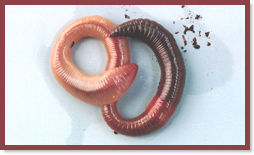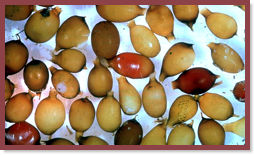
Biology of the Night Crawler (Lumbricus terrestris)
By Doug Collicutt
Description
The Night Crawler (Lumbricus terrestris) is a large worm, measuring up to 25 cm in length and up to 1 cm in diameter. They have a distinct, darker coloured "head" end which does contain the primitive "brain" of the animal, and this tends to be the end of the worm that travels "forward" the most. The "tail" end of the worm tends to be more flattened than the head and lighter in colour. Common garden worms (Aporrectodea spp. - I couldn't track down which species we have here) are smaller and don't have a dark coloured head end.
Worms do have a proper top (dorsal) and bottom (ventral) surface, they are not just symmetrical tube-like organisms. The surface of the worm's skin is smooth and slimy, but also has many tiny bristles or "setae" (pronounced set-ay) protruding from it. These help the worm move and serve to anchor it in its burrows for self defense. The setae are part of the reason that robins have such a hard time pulling worms out of the ground. If you place a big Night Crawler on a piece of cardboard or paper, you can hear the setae scraping as the worm crawls!
(Dr. David Polcyn with the Dept. of Biology, California State University, San Bernardino sent in a slight correction: "The setae actually prevent the worm from moving (or being pulled) backwards, but don't help anchor it if it is being pulled from the front end. My guess is that robins have a hard time pulling them out just because of the friction between the skin and the surrounding soil". Thanks, David.)
|
Basic Worm Biology
Without going into a lot of details, here's a few tidbits of worm biology, just a view things that came to mind and seem to be the kinds of things people most often ask about.
The body plan of an earth worm is basically a segmented tube. Each segment is a separate fluid-filled compartment surrounding the digestive tract (gut) which runs the length of the worm's body. Many of the worm's internal organs are also segmented, occurring as separate units in each segment, but there is considerable specialization in the head end of the worm. The "brain", "hearts" and other organs are clustered in the head end. Earth worms have no eyes, but they do have cells which are sensitive to light. They do not have ears, but can feel vibrations in the ground. Earth worms don't have lungs, they absorb oxygen directly through their moist skin, which is kept moist by mucous secreting cells. If a worm dries out, it will suffocate.
Worms move by a process known as "peristaltic contraction". A worm's body is a fluid filled tube divided into separate segments. There are circular muscles that surround (ring) each segment and longitudinal muscles running from segment to segment for the length of the worm. Contraction of the longitudinal muscles shortens and widens the segments of worms body. Circular muscle contraction lengthens and narrows the segments. By alternating these processes in waves down it's entire body length the worms crawls forward or backward. Inside its tunnel the widening of several segments serves to anchor that part of the body against the tunnel walls. The "leading end" segments are then elongated by circular muscle contraction (squeezing), pushing that end forward, and the "trailing end" is drawn up by longitudinal muscle contraction.
Worms can survive being cut in half! Well, for a little while, at least. It is usually only the head end that will regenerate some segments in the lower end and become a viable worm again. The lower end cannot regenerate a head. However, most often, when cut in half, worms die.
Classification
The taxonomic classification of the Night Crawler is as follows. (Warning: Don't try to pronounce these names while chewing gum, serious lingual damage may occur.)
| Kingdom: | Animalia |
| Phylum: | Annelida |
| Class: | Oligochaeta |
| Order: | Haplotaxida |
| Suborder: | Lumbricina |
| Family: | Lumbricidae |
| Genus: | Lumbricus |
| Species: | terrestris |
Name
Night Crawlers get their common name because they do crawl around on top of the ground at night. They are also know as "dew worms", probably because they are found more commonly on nights when the ground is moist from a dew or rain.
The scientific name for Night Crawlers derives as follows:
Lumbricus: A Latin word for earthworm.terrestris: Another Latin term, meaning "of or belonging to the earth".
So, Lumbricus terrestris is "earthworm of the earth". (I know that's a bit redundant, but at least it makes sense!)
Habitat and Range
The Night Crawler is not native to Manitoba, nor to North America. It is a European species that was introduced to the new world with the advent of European settlement. It is most prevalent in the southwestern third of Manitoba, the agricultural region. Actually, it seems that all of Manitoba's earthworms are exotic species! There are very few native North American species of worms, and none of them are thought to have made it into Manitoba after the retreat of the glaciers with the end of the last ice-age. (I still find it hard to believe that Manitoba has no native earth worms! I'll keep checking around to see if I can verify this fact, and post an update later on.) I haven't been able to track down how many species of worms there are in Manitoba, yet. Ontario boasts 19 different species and North Dakota has 10.
Moist soils that are rich in organic matter are the preferred habitat of Night Crawlers. Proximity to human habitation is a major factor in the distribution and numbers of Night Crawlers. Remember, this is an introduced species, so it is most likely to occur where people have been active in working or altering the soil. Golf courses and farm fields near cities are some of the best places to find Night Crawlers. Forested lands along major waterways are also good places to find them.
Populations
The populations of Night Crawlers will vary dramatically with soil conditions. It's thought that they require about 1500 cubic centimetres of soil each in order to thrive, that's equivalent to a cube of soil 12 cm on a side. If you laid such blocks out on a lawn, you'd have about 70 of them per square metre, so populations of Night Crawlers could be as high as 70 per square metre of lawn! However, published estimates tend to put their populations at a more modest 10-15 per square metre, still a lot of worms! The populations probably show a trend towards increasing numbers from spring until late fall. Presumably the hardships of winter take their toll on worm populations. How Night Crawler populations relate to the populations of other earth worm species is uncertain. Each species probably has its preferences for soil conditions and may dominate the overall worm population in its preferred habitat.
Life Cycle
Night Crawlers, and most other worms, are hermaphrodites. That is, each individual worm contains both male and female reproductive organs. However, the worms must still mate with another of their species in order to reproduce. When two worms mate, they lie alongside one another, and both transfer sperm to the other. Each will lay one or more capsules (like a cocoon for the eggs), from which will emerge one or two fully formed tiny worms. The familiar thickened "band" near the front end of most worm species is a structure called the clitellum (see above, also). It secretes the mucous and other substances that form the capsule containing the fertilized eggs.
|
It's thought that Night Crawlers mate and lay eggs mainly in the spring and fall, when soil moisture levels tend to be higher. Each worm may mate and lay eggs several times each year, but they produce relatively few offspring per year, perhaps only 10-15 for each adult worm. It may take the tiny worms up to a year to reach full size and sexual maturity. How long they live after this in the wild isn't certain, best guesses are anywhere from 3-8 years, but captive worms have been know to live for 10 years!
Carry on for More Night Crawler Biology!![]()
| You can help NatureNorth produce more great articles with a secure donation through PayPal. Our Google Adsense ads pay our server costs, but that's about it. To learn more follow this link: Support NatureNorth. Thank-you! | |
Return to: Night Crawlers!| More Biolgy of Night Crawlers| Fall Issue | NatureNorth Front page



